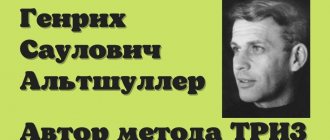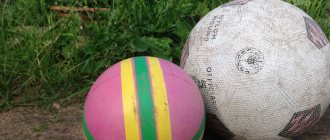Master class “Use of TRIZ technology elements in joint activities between a teacher and children”
Transcript
1 Master class “Use of elements of TRIZ technology in joint activities of a teacher with children” was conducted by: Ignatieva L.A. teacher of the MKDOU Zdvinsky kindergarten “Firefly” Goal: increasing the competence of teachers by using TRIZ elements in educational activities aimed at developing the cognitive activity of preschoolers. Objectives: 1. To introduce teachers to the “System Operator” method and the rules of TRIZ technology games. 2. Improve skills in using gaming equipment. 3. Arouse interest in TRIZ technology among the master class participants. Dear colleagues! Today I bring to your attention a master class on the topic: “Using elements of TRIZ technology in the joint activities of a teacher with children” (Slide 1) So what is TRIZ? (this is the theory of solving inventive problems) TRIZ for preschoolers is a system of collective games and activities designed not to change the main program, but to maximize its effectiveness. “You need to start learning creativity as early as possible.” This is what the founder of the theory, Genrikh Saulovich Altshuller, and his followers believed. (Slide 2)
2 This technology can be used in almost all types of children's activities: both in educational activities and in games and in routine moments. The main difference between TRIZ technology and the classical approach to preschool development is the opportunity for children to independently search for answers to questions, solve problems, and analyze, rather than children repeating ready-made material. Positive aspects of TRIZ: (Slide 3) Children’s range of ideas is enriched, their vocabulary grows, and their creative abilities develop; TRIZ helps to form dialectics and logic, helps to overcome shyness, isolation, and timidity; a little person learns to defend his point of view, and when finding himself in difficult situations, to independently find original solutions; TRIZ promotes the development of visual-figurative, causal, heuristic thinking (making a discovery is possible); memory, imagination, affects other mental processes. The introduction of TRIZ must begin with preparatory work on the study of the Natural and Man-made world, living and inanimate nature, as well as the characteristics of objects in the surrounding world: shape, color, size, relief, material, etc. (slide 4) Features of objects are indicated by pictograms that you can come up with with your children or take ready-made ones from TRIZ manuals or from the Internet; Throughout the entire work, the pictograms should not change; the signs must be studied step by step, adding several from group to group (17 signs). The study of each sign takes from 7-5 to 2 days, depending on the age of the children.
3 Moving from theory to practice, I would like to present to your attention the following TRIZ games that I use in joint activities with children: “Wonderful Bag”; “Teremok” 1. Game “Wonderful Bag” (slide 5) Purpose: This game allows you to teach children to describe an object using attributes: color, shape, taste, smell, etc. Develop tactile sensations, visual perception, the ability to work with a sign diagram, visual-figurative thinking, and speech. Cultivate interest in joint games, the ability to listen to the opinion of a peer. Equipment: “Cubes” with feature cards 3 pcs., a wonderful bag with objects. How to play: Children sit in a semicircle. The child guesses the object by touch, names it, and takes it out of the bag. Having thrown the “Dice” with cards of characteristics, he describes the object according to the 3 dropped characteristics, while naming the name of the characteristic. If the child does not guess the object tactilely, then he simply takes it out and gives it a description. For example: The child guesses and takes out the object. This is a ball. The names of the features dropped out: “Color”, “Shape”, “Size”. The child describes the object: “The ball is yellow in color with a red stripe, round in shape, and small in size relative to (compared to) a basketball.” 2. Game “Teremok” (by analogy with a fairy tale) (slide 6) Goal: to develop the ability to compare and generalize one’s own observations, the desire to search. Age years
4 Children “turn” into objects (objects are selected on the table or in a bag) and come to the little house according to the principle of similarity and dissimilarity. Determine how they are similar to the previous object, i.e. "guest" or "host". The teacher begins the fairy tale: “There is a teremok in a field. He is neither short nor tall. As if across a field - a field, a guest is running, stopping at the gate and knocking." The object that "lives in the little house" can be known to children. The teacher informs in advance that, for example, a ball has decided to live in the tower. “I’m a thermometer,” says the child, “I’m as red as the ball.” Let me live with you” (The ball launches the “guest”; if the child cannot find the similarity, the other children help) 3. “System Operator” method (slide 7) Using the TRIZ “System Operator” technique allows you to consider an object in time and space. Regular use of the CO technique develops in a child “system analysis skills, systems thinking, or multi-screen thinking” (G.S. Altshuller). In kindergarten, this technique was called “Magic TV” or “Magic Screen”. For older children, a nine-screen is available; for younger children, “stripped-down” options are used: Vertical and Horizontal three-screen, Five-screen. What is “Magic TV”? (slide 8)
5 How does a system operator work? In essence, the system operator is a kind of template for the correct thought process. It contains such analysis criteria as: System. This is the object that we are going to study or even transform, has its own function (functions somehow) Subsystem. This is what is included in the system and its constituent parts. Supersystem. This is a certain higher level system, of which the object we are studying is a part. The supersystem can be generic (a tree can belong to the generic classification “plant”) or by location (a tree can be classified as a forest, garden, park, etc.) Past. What/who was the object before? What were its properties, capabilities, tasks? The present. What does the object represent today? What is he like? What are its functions? Future. What will happen to the object after some time? Which one exactly? Why? Each screen reflects a certain part of the World at a certain time of its existence. The central screen is the system currently selected for review.
6 Three screens on the horizontal middle level reflect changes in the system during the transition from the Past to the Present and the Future. (slide 9) And three middle screens at the vertical level are a subsystem and a supersystem. (Slide 10) To more successfully remember the order of viewing systems, M. Gafitulin’s poem “Something” helps children (Slide 11) If we look at something. It's something for something. It's something from something. It's something, part of something. Something was this something. Something will happen with this. Take something now and look at it on the screens!
7 (C system) (F function) (PS subsystem) (NS supersystem) (PrS past system) (BuS future system) Usually I tell the children a riddle to create some intrigue (a surprise moment). There are a lot of windows in it. We live in it. This is the House. Now let's try to consider the system: House. In the “Future” screen, draw a house of the future. Looking at the screens of the “Magic TV” you can make up a story (development of coherent speech). (Slide 11) I would like to end my master class with a statement from Genrikh Saulovich Altshuller, the founder of TRIZ technology. “Every child is initially talented and even brilliant, but he must be taught to navigate the modern world in order to achieve maximum effect with a minimum of costs.”
"TRIZ technology. Method "System analysis". Master class for preschool teachers
Municipal budgetary preschool educational institution
“Kindergarten No. 53 “Strawberry”
Master class for teachers
TRIZ technology
Method
"System analysis"
Purpose of the master class
: practical development of TRIZ technology.
Tasks:
1. Introduce colleagues to the theoretical foundations of technology;
2. Give an idea of the method “System (morphological) analysis”;
3. To introduce the practical application of the method in educational activities.
Form of conduct:
pedagogical living room.
Audience:
pedagogical community.
Relevance.
One of the important factors for a child’s success in school life is his ability to model, perform comparison, analysis, and synthesis operations.
From an early age, a child begins to think systematically, imagining the world in his imagination as an endless combination of various elements-signs and forms. Gradually, the child discovers that such elements can be controlled: combining them in different ways, replacing some elements with others, inventing objects that do not exist in reality. One of the interesting methods for developing imagination and thinking is morphological analysis.
Morphological analysis has a positive effect on the formation of a preschooler’s cognitive activity, i.e. on the need to acquire new knowledge, the ability to use it independently and rationally (find characteristic features in objects and phenomena of the surrounding world, classify objects according to certain characteristics, draw inferences).
I present to your attention a master class on using
the “System Analysis” method of TRIZ technology.
Method morphological analysis (MMA) is very effective for developing creative imagination, fantasy, and overcoming stereotypes. One of the interesting methods involving several mental operations (analysis, synthesis, generalization, comparison), the author of this method is F. Zwicky. The essence of the method is that mental operations are carried out using a table in which some indicators are set vertically and horizontally. The intersection of the values of these indicators is the basis of analytical activity. Its use allows the teacher to show in an accessible form the variability of signs of objects in the surrounding world even to the youngest children. This tool forms the mobility of thinking, the child’s ability to assimilate the principle of variability.
MMA is also very good for the formation of elementary mathematical concepts, familiarization with the environment, preparation for literacy, in project activities, visual and musical activities, etc.




